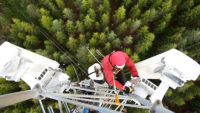Confined space safety basics
What you need to know about the Z117.1 Standard

Photo credit: Thank you for your assistant / iStock / Getty Images Plus
Confined spaces come in many forms — from silos and storage bins to tanks and maintenance holes. Every confined space presents hazards to those who enter and operate within them. A space may be oxygen deficient or oxygen enriched. There may be the potential for falls, engulfment or contact with hazardous energy.
Each of these hazards has the potential to cause serious injuries and fatalities. From 2011-2018, more than 1,000 U.S. workers died from injuries involving confined spaces. The key is identifying and assessing hazards in advance so workers can enter, exit and perform their tasks safely.
Improving safety with the Z117.1 Standard
The recently updated ANSI/ASSP Z117.1 standard establishes requirements and procedures for the safety and health of employees who work in, and in connection with, confined spaces. The guidance provided in the standard can help you assess and manage risks within the different types of confined spaces you may encounter.
“This new revision goes above and beyond regulatory requirements to ensure that the reader understands the complexity of confined spaces and how to protect the entry team members,” says Z117.1 Committee Chair Terry Krug, M.S., CSP, CIH. “It has procedures and practices and explains the intricacies of instrument testing and other operations to a greater degree.”
This latest edition of Z117.1 includes updated guidance on atmospheric testing to ensure that readers have a detailed understanding of testing instrumentation, how to use it and ensure that it’s functioning properly. The standard requires that calibration of testing instruments be conducted in accordance with the manufacturer’s recommendations to ensure accuracy, and that a function check be performed prior to each day’s use.
Cleaning and decontamination requirements have also been expanded to ensure that those operating in confined spaces are using the right PPE and taking the proper precautions to decontaminate equipment after they have exited the space. Z117.1-2022 also includes updated information on rescue training to ensure that rescue teams are available, properly trained and qualified to extricate someone from a confined space if necessary.
Addressing hazards and risks
Improving safety on confined space projects takes a lot of planning. As such, the updated Z117.1 standard requires that a qualified person conduct an initial survey of the premises and/or operations and that appropriate procedures are developed prior to entry.
Whatever hazards may be present within a space, this survey should determine the scope of the hazard exposure, the magnitude of the hazard, the likelihood of the hazard occurrence and the consequences of the hazard occurrence.
“You really have to do your homework and find out the history of a space, what kind of hazards have been identified and what the space is used for,” Krug explains. “You can’t just go into a space, take your four-gas meter and think you have it all under control because there are a lot of other hazards that need to be looked at.”
Z117.1 outlines common hazards that you may find in confined spaces, as well as guidance on how to properly assess those hazards before workers enter the space, including:
Oxygen deficiency or enrichment
Confined spaces with too much or too little oxygen present very serious hazards for occupants. Oxygen deficiency can lead to conditions ranging from increased pulse rate and fatigue to severe brain damage or death, depending on the oxygen level within the space. Oxygen enrichment increases the probability of fire and explosions from flammables/combustible gasses, vapors and/or combustible dust. Those surveying the space must ensure that an oxygen level of 19.5% to 23.5% by volume is maintained.
Toxic atmospheres
Oxygen isn’t the only gas to be concerned about in confined spaces. Asphyxiants and toxic atmospheres are the leading cause of confined space-related fatalities. Before anyone enters a confined space, entry supervisors must conduct atmospheric tests. This could include testing for flammable/combustible gas, toxic gas or vapor in the atmosphere that presents or could present at hazardous levels.
“You could have carbon dioxide or carbon monoxide in a space, and those cannot be detected by the sense of smell,” Krug says. “That’s why you need to use the proper instruments before you go into a space so you can categorize those hazards effectively and put controls in place.”
If the atmosphere within a space is found to have levels of oxygen, flammability or toxicity that are not within acceptable limits, entry into the space must be prohibited until appropriate controls are implemented, appropriate work procedures established and appropriate PPE is used by trained entry team members.
Engulfment
Confined spaces such as silos may contain the potential for workers to be engulfed by grain, water or other materials. Although the potential for engulfment cannot be measured with an instrument, there are steps you can take to assess the risk. The space and any adjacent spaces should be examined for ruptures in walls or any structural weaknesses that could cause a worker to be engulfed.
Falls
Working on elevated surfaces within confined spaces (such as in water towers or grain elevators) also presents the potential for falls. If entry and exit into and out of a confined space presents fall hazards, you must use warning systems, barricades or other appropriate methods to mitigate those risks. If active fall protection systems are used, they must comply with the requirements of the ANSI/ASSP Z359 Fall Protection Code.
Learn more about how the ANSI/ASSP Z117.1 standard can help you address the hazards and risks in confined spaces to get workers in and out safely.
Looking for a reprint of this article?
From high-res PDFs to custom plaques, order your copy today!








.jpg?t=1721257160)
